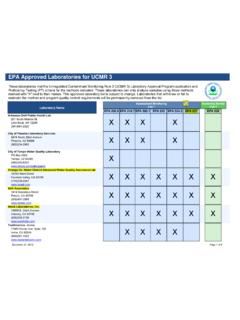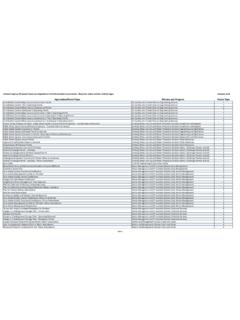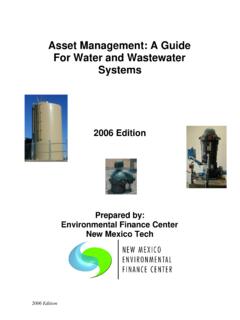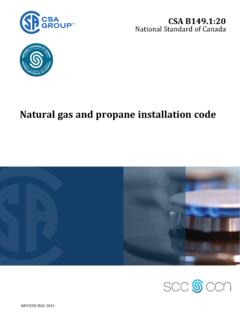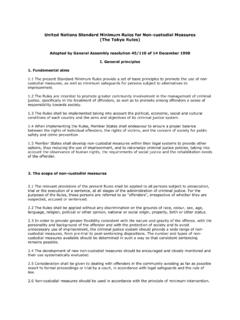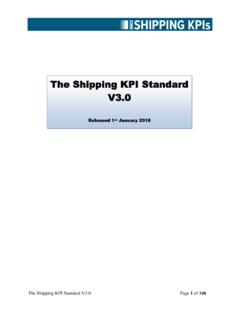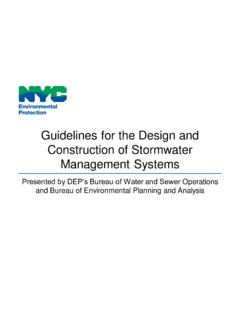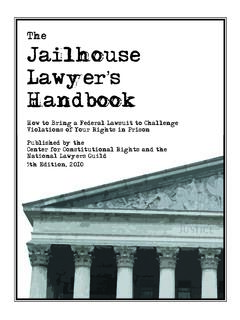Transcription of Vermont Stormwater Management Manual
1 2017 Vermont Stormwater Management Manual Rule and Design Guidance Vermont Agency of Natural Resources This document combines the duly adopted 2017 Vermont Stormwater Management Manual Rule (Environmental Protection Rule, Chapter 36, effective July 1, 2017) and the Agency s Design Guidance for applying the Rule. All design guidance elements of this document include a title or heading indicating Design Guidance and are highlighted in gray. In addition, figures, tables, and drawings that are labeled as Design Guidance, are not components of the adopted Rule, but serve as design guidance for applying the Rule. Tables or figures that are not labeled as Design Guidance are required elements of the adopted Rule, which must be complied with. Vermont Stormwater Treatment Standards Acknowledgements The information presented in the 2017 Vermont Stormwater Management Manual Rule and Design Guidance is the result of a collaborative effort by the Vermont Agency of Natural Resources, the Vermont Agency of Transportation, Stone Environmental, Inc.
2 , Horsley Witten Group, Inc., Adamant Accord, with additional assistance from Otter Creek Engineering, and was assembled in consideration of stakeholder and designer participation and comment. The Vermont Agency of Natural Resources is an equal opportunity agency and offers all persons the benefits of participating in each of its programs and competing in all areas of employment regardless of race, color, religion, sex, national origin, age, disability, sexual preference, or other non-merit factors. This document is available upon request in large print, Braille, or CD. VT Relay Service for the Hearing Impaired 1-800-253-0191 TDD>Voice 1-800-253-0195 Voice>TDD Vermont Stormwater Treatment Standards Table of Contents Introduction and Purpose.
3 1-1 Regulatory Authority and Applicability .. 1-2 Anti-degradation .. 1-2 Protection of Groundwater .. 1-2 Effective Date and Transition .. 1-3 Site Design and Stormwater Treatment Practice Sizing Criteria .. 2-1 Site Planning and Design .. 2-1 Design Guidance: Initial Site Layout .. 2-1 Design Guidance: Conserving Natural Vegetation and Minimizing Impervious Cover .. 2-1 Design Guidance: Setbacks for Water Resource Protection and Restoration .. 2-2 Design Strategies for Meeting Applicable Treatment Standards on Already Developed Sites .. 2-4 Treatment Standards .. 2-6 Post-Construction Soil Depth and Quality .. 2-7 Runoff Reduction Framework .. 2-8 Groundwater Recharge Standard (ReV) .. 2-8 Water Quality Treatment Standard (WQTS) .. 2-10 Design Guidance: 2017 VSMM Water Quality Practice Selection.
4 2-13 Design Guidance: Water Quality Practice Selection Feasibility Considerations .. 2-13 Design Guidance: Water Quality Practice Selection Flowchart .. 2-16 Channel Protection Standard .. 2-19 Overbank Flood Protection Standard (QP10) .. 2-24 Extreme Flood Protection Standard (QP100) .. 2-25 Stormwater Hotspots .. 2-26 Redevelopment .. 2-27 Downstream Analysis for QP10 and QP100 .. 2-28 Post-Construction Soil Depth and Quality .. 3-1 Post-Construction Soil Depth and Quality Feasibility .. 3-1 Post-Construction Soil Depth and Quality Treatment .. 3-2 Post-Construction Soil Depth and Quality Vegetation and Landscaping .. 3-4 Acceptable Stormwater Treatment Practices .. 4-1 Pre-Treatment Practices .. 4-2 Pre-Treatment Swale .. 4-3 Pre-Treatment Filter Strip.
5 4-5 Vermont Stormwater Treatment Standards Sediment Forebay .. 4-6 Deep Sump Catch Basins .. 4-8 Proprietary Pre-Treatment Devices .. 4-9 Non-Structural 4-11 Reforestation and Tree Planting .. 4-11 Design Guidance: Reforestation and Tree Planting Design Summary .. 4-14 Simple Disconnection .. 4-16 Design Guidance: Simple Disconnection Design Summary .. 4-19 Disconnection to Filter Strips and Vegetated Buffers .. 4-21 Design Guidance: Disconnection to Filter Strips and Vegetated Buffers Design Summary .. 4-26 Watershed Hydrology Protection .. 4-28 Design Guidance: Watershed Hydrology Protection Design Summary .. 4-33 Structural Stormwater Treatment Practices .. 4-35 Bioretention .. 4-35 Design Guidance: Bioretention Design Summary .. 4-41 Dry Swales.
6 4-42 Design Guidance: Dry Swale Design Summary .. 4-46 Infiltration Trenches and Basins .. 4-48 Design Guidance: Infiltration Trenches and Basins Design Summary .. 4-57 Filtering Systems .. 4-59 Design Guidance: Filtering Systems Design Summary .. 4-66 Treatment Wetlands .. 4-67 Design Guidance: Treatment Wetlands Design Summary .. 4-74 Wet Ponds .. 4-75 Design Guidance: Wet Ponds Design Summary .. 4-81 Green Roofs .. 4-82 Design Guidance: Green Roof Design Summary .. 4-85 Permeable Pavement .. 4-87 Design Guidance: Permeable Pavement Design Summary .. 4-90 Rainwater Harvesting .. 4-91 Design Guidance: Rainwater Harvesting Design Summary .. 4-94 Alternative Stormwater Treatment Practices .. 4-95 Existing Alternative Systems .. 4-96 New-Design Alternative Systems.
7 4-96 Detention and Conveyance Practices .. 5-1 Dry Detention Ponds .. 5-2 Storage Vaults .. 5-3 Conveyance Swales .. 5-3 Vermont Stormwater Treatment Standards Public Transportation Projects .. 6-1 Applicability of the Stormwater Treatment Standards to Public Transportation Projects .. 6-1 Redevelopment - Major 6-1 Redevelopment with Expansion .. 6-3 New Construction .. 6-3 Site Balancing for Stormwater Discharges Associated with Public Transportation Reconstruction Projects .. 6-4 Post-Construction Soil Depth and Quality Requirements for Public Transportation Projects .. 6-4 Requirements for Public Transportation Projects .. 6-5 Additional Acceptable STPs for Public Transportation Projects .. 6-6 Infiltration Berm .. 6-6 Media Filter Drain.
8 6-9 Runoff Control Measures for Public Transportation Project Redevelopment Major Maintenance Projects .. 6-18 Modifications to Acceptable STPs .. 6-18 Plunge Pools .. 6-18 Check Dams .. 6-22 Definitions .. 7-1 Vermont Stormwater Treatment Standards List of Tables Table 2-1. Treatment Standard Summary .. 2-6 Table 2-2. Stormwater Treatment Practices that Reduce Runoff .. 2-8 Table 2-3. List of Practices Acceptable for Meeting the Groundwater Recharge Standard .. 2-9 Table 2-4. Recharge Factors Based on Hydrologic Soil Group (HSG) .. 2-9 Table 2-5. Runoff Curve Numbers for Woods in Good Condition .. 2-20 Table 2-6. List of Practices Acceptable for Meeting the Channel Protection Standard through Hydrologic Condition Method .. 2-21 Table 2-7. Allowable Increases for Downstream Analysis.
9 2-29 Table 4-1. Required Simple Disconnection Lengths (in direction of flow) for WQV credit .. 4-18 Table 4-2. Required Filter Strip and Vegetated Buffer Lengths (in direction of flow) by Soil Infiltration Rate and Slope 4-25 Table 4-3. Protective Strip Width Guide .. 4-29 Table 4-4. Maximum Allowable Distance between Drainage Conveyance 4-30 Table 4-5. Flow Path Sizing .. 4-32 Table 6-1. Media Filter Drain Mix .. 6-14 Vermont Stormwater Treatment Standards List of Figures Figure 2-1. Approximate Ranges for Storms Comprising Treatment Standards Sizing Criteria, Design Guidance .. 2-7 Figure 2-2: Graphical Depiction of Coincident Peak Phenomena (ARC, 2001), Design Guidance .. 2-28 Figure 3-1. Post-Construction Soil Depth and Quality Standard Field Verification, Design Guidance.
10 3-1 Figure 4-1. Pre-Treatment Swale, Design Guidance .. 4-3 Figure 4-2. Pre-Treatment Filter Strip, Design Guidance .. 4-5 Figure 4-3. Sediment Forebay, Design Guidance .. 4-7 Figure 4-4. Deep Sump Catch Basin, Design Guidance .. 4-8 Figure 4-5. Simple Disconnection, Design Guidance .. 4-16 Figure 4-6. Disconnection to Filter Strips and Vegetated Buffers, Design 4-21 Figure 4-7. Disconnection to Filter Strip and Vegetated Buffers, via Level Spreader, Design Guidance .. 4-24 Figure 4-8. Disconnection to Filter Strips and Vegetated Buffers, via Level Spreader, Design Guidance .. 4-24 Figure 4-9: Bioretention, Design Guidance .. 4-36 Figure 4-10. Dry Swale, Design Guidance .. 4-42 Figure 4-11. Infiltration Trench, Design Guidance .. 4-49 Figure 4-12. Dry Well, Design Guidance.

